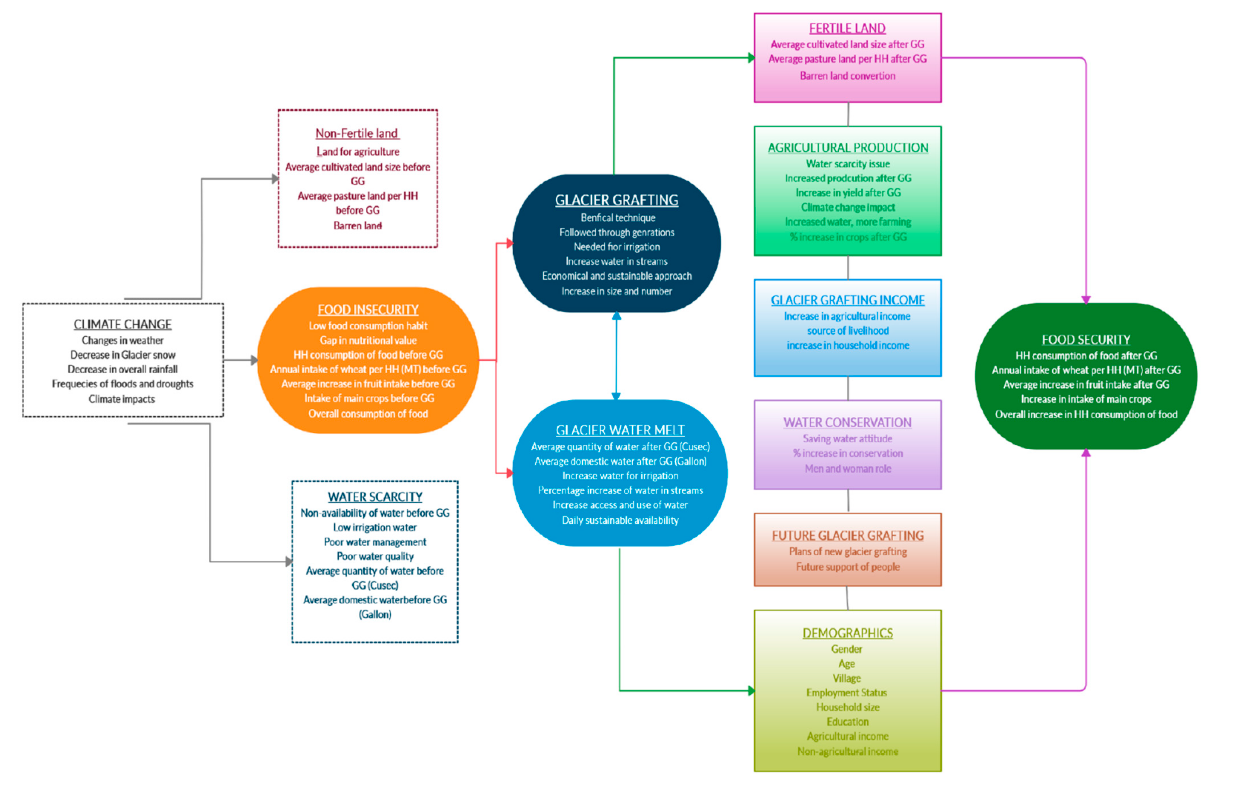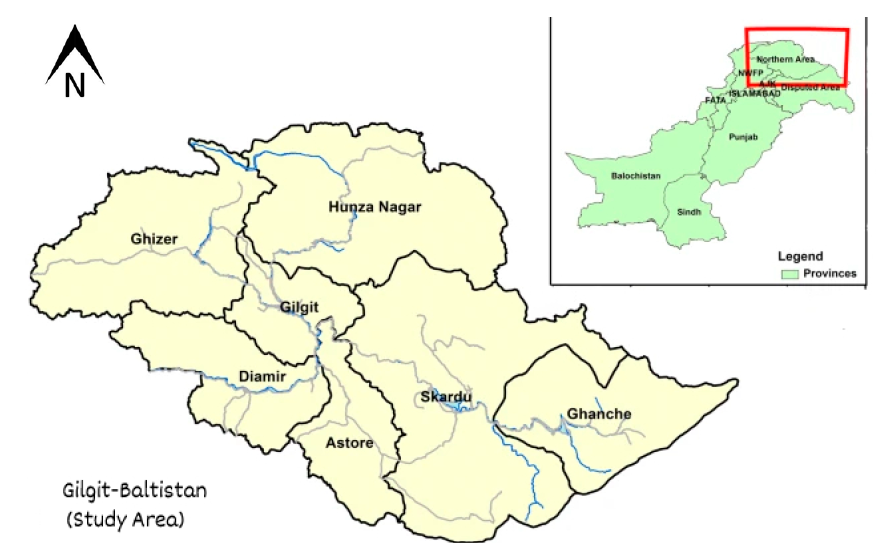Perceptions of Glacier Grafting: An Indigenous Technique of Water Conservation for Food Security in Gilgit-Baltistan, Pakistan
Abstract
:1. Introduction
Genesis of the Problem: Agricultural Production and Food (In-)Security
- What is respondents’ perception of climate change for water availability and agricultural production for food security?
- What is respondents’ perception regarding glacier grafting for water provision for agricultural production and food security?
- What is respondents’ perception about the contribution of glacier melt water in improving socio-economics dynamics?
2. Literature Review
2.1. Glacier-Grating: A Technique
2.2. Community Participation for Glacier Grafting
2.3. Water for Food Security
2.4. Conceptual Framework
3. Research Methodology
3.1. Study Area
3.2. Sampling Technique and Data Collection
3.3. Estimation of Variables and Statistical Modeling (Construction of Variables)
Dependent Variables
- (1)
- Glacier Grafting = f (demographics, glacier melt water, water unavailability, climate change, agricultural land, fertile land, agricultural production, food security, food insecurity, glacier grafting income, water conservation, future glacier grafting).
- (2)
- Glacier Melt Water = f (demographics, glacier grafting, water unavailability, climate change, agricultural land, fertile land, agricultural production, food security, food insecurity, glacier grafting income, water conservation, future glacier grafting).
- (3)
3.4. Data Analysis Techniques
4. Results and Discussion
4.1. GG and GMW for Food Security
4.2. Significance of Glacier Grafting
4.3. Glacier Melt Water (GMW)
4.4. GMW and Food Security
5. Conclusions
Author Contributions
Funding
Institutional Review Board Statement
Informed Consent Statement
Data Availability Statement
Acknowledgments
Conflicts of Interest
References
- Duran-Encalada, J.A.; Paucar-Caceres, A.; Bandala, E.R.; Wright, G.H. The impact of global climate change on water quantity and quality: A system dynamics approach to the US–Mexican transborder region. Eur. J. Oper. Res. 2017, 256, 567–581. [Google Scholar] [CrossRef]
- Gosling, S.N.; Arnell, N.W. A global assessment of the impact of climate change on water scarcity. Clim. Chang. 2016, 134, 371–385. [Google Scholar] [CrossRef]
- Khayyam, U.; Noureen, S. Assessing the adverse effects of flooding for the livelihood of the poor and the level of external response: A case study of Hazara Division, Pakistan. Environ. Sci. Pollut. Res. 2020, 27, 19638–19649. [Google Scholar] [CrossRef] [PubMed]
- Abdollahbeigi, M. Non-Climatic Factors Causing Climate Change. J. Chem. Rev. 2020, 2, 292–308. [Google Scholar]
- Vairavamoorthy, K.; Gorantiwar, S.D.; Pathirana, A. Managing urban water supplies in developing countries—Climate change and water scarcity scenarios. Phys. Chem. Earth 2008, 33, 330–339. [Google Scholar] [CrossRef]
- Hasegawa, T.; Fujimori, S.; Havlík, P.; Valin, H.; Bodirsky, B.L.; Doelman, J.C.; Fellmann, T.; Kyle, P.; Koopman, J.F.L.; Lotze-Campen, H.; et al. Risk of increased food insecurity under stringent global climate change mitigation policy. Nat. Clim. Chang. 2018, 8, 699–703. [Google Scholar] [CrossRef]
- Tito, R.; Vasconcelos, H.L.; Feeley, K.J. Global climate change increases risk of crop yield losses and food insecurity in the tropical Andes. Glob. Chang. Biol. 2018, 24, e592–e602. [Google Scholar] [CrossRef]
- Zulfiqar, M.; Khan, M.J.; Abbasi, I.K.; Tariq, M.; Ali, J.; Karim, M.; Ahmad, R. Threats of Global Warming for Pakistan’s Agriculture: An Evidence from Shigari Kalan Watershed, Skardu. Sarhad J. Agric. 2018, 34, 569–574. [Google Scholar]
- Ul-Allah, S.; Khan, A.A.; Fricke, T.; Buerkert, A.; Wachendorf, M. Effect of fertiliser and irrigation on forage yield and irrigation water use efficiency in semi-arid regions of Pakistan. Exp. Agric. 2015, 51, 485–500. [Google Scholar] [CrossRef]
- Buytaert, W.; Cuesta-Camacho, F.; Tobón, C. Potential impacts of climate change on the environmental services of humid tropical alpine regions. Glob. Ecol. Biogeogr. 2011, 20, 19–33. [Google Scholar] [CrossRef]
- Marzeion, B.; Cogley, J.G.; Richter, K.; Parkes, D. Attribution of global glacier mass loss to anthropogenic and natural causes. Science 2014, 345, 919–921. [Google Scholar] [CrossRef]
- Fayos, C.B. Competition Over Water Resources: Analysis and Mapping of Water-Related Conflicts in the Catchment of Lake Naivasha, Kenya; ITC: Geneva, Switzerland, 2002. [Google Scholar]
- Tir, J.; Stinnett, D.M. Weathering climate change: Can institutions mitigate international water conflict? J. Peace Res. 2012, 49, 211–225. [Google Scholar]
- Change, I.; Justice, C. Climate. Impacts, Adaptation and Vulnerability, Contribution of Working Group II to the Fourth Assessment Report of the IPCC. In Climate Change; Cambridge University Press: Cambridge, UK, 2007; ISBN 978-0521-88010-7. [Google Scholar]
- Sharma, B.; Sharma, D. Impact of Climate Change on Water Resources and Glacier Melt and Potential Adaptations for Indian Agriculture; International Water Management Institute: New Delhi, India, 2008. [Google Scholar]
- Steinberg, J. Intangible ecologies: Intangible Ecologies: Sacred mountain landscapes in a changing climate. In Mt Forum Bull; The Mountain Institute: Washington, DC, USA, 2008; Volume 8, pp. 3–4. [Google Scholar]
- Khayyam, U. Floods: Impacts on livelihood, economic status and poverty in the north-west region of Pakistan. Nat. Hazards 2020, 102, 1033–1056. [Google Scholar] [CrossRef]
- Rasul, G.; Hussain, A.; Khan, M.A.; Ahmad, F.; Jasra, A.W. Towards a Framework for Achieving Food Security in the Mountains of Pakistan; International Centre for Integrated Mountain Development (ICIMOD): Kathmandu, Nepal, 2014. [Google Scholar]
- Huq, S.; Kovats, S.; Reid, H.; Satterthwaite, D. Reducing Risks to Cities from Disasters and Climate Change. Environ. Urban. 2007, 19, 3–15. [Google Scholar]
- Bradley, R.S.; Vuille, M.; Diaz, H.F.; Vergara, W. Threats to water supplies in the tropical Andes. Science 2006, 312, 1755–1756. [Google Scholar] [CrossRef]
- Augustin, M.A.; Riley, M.; Stockmann, R.; Bennett, L.; Kahl, A.; Lockett, O.M.; Sanguansri, P.; Stonehouse, W.; Zajac, I.; Lynne Cobiac, T. Role of food processing in food and nutrition security. Trends Food Sci. Technol. 2016, 56, 115–125. [Google Scholar] [CrossRef]
- Rosegrant, M.W.; Cline, S.A. Global food security: Challenges and policies. Science 2003, 302, 1917–1919. [Google Scholar] [CrossRef]
- Knox, J.; Hess, T.; Daccache, A.; Wheeler, T. Climate change impacts on crop productivity in Africa and South Asia. Environ. Res. Lett. 2012, 7, 34032. [Google Scholar] [CrossRef]
- WFP. 2018 Global Report on Food Crises. 2018. Available online: https://www.wfp.org/content/global-report-food-crises-2018 (accessed on 7 January 2021).
- Rijsberman, F.R. Water scarcity: Fact or fiction? Agric. Water Manag. 2006, 80, 5–22. [Google Scholar] [CrossRef]
- Turral, H.; Burke, J.J.; Faurès, J.-M. Climate Change, Water and Food Security; Food and Agriculture Organization of the United Nations: Rome, Italy, 2011. [Google Scholar]
- Barnett, T.P.; Adam, J.C.; Lettenmaier, D.P. Potential impacts of a warming climate on water availability in snow-dominated regions. Nature 2005, 438, 303. [Google Scholar] [CrossRef]
- Seckler, D.; Barker, R.; Amarasinghe, U. Water scarcity in the twenty-first century. Int. J. Water Resour. Dev. 1999, 15, 29–42. [Google Scholar] [CrossRef]
- Fulginiti, L.E.; Perrin, R.K. Agricultural productivity in developing countries. Agric. Econ. 1998, 19, 45–51. [Google Scholar] [CrossRef]
- Ahmad, M.; Farooq, U. The state of food security in Pakistan: Future challenges and coping strategies. Pak. Dev. Rev. 2010, 49, 903–923. [Google Scholar]
- Alam, K. Farmers’ adaptation to water scarcity in drought-prone environments: A case study of Rajshahi District, Bangladesh. Agric. Water Manag. 2015, 148, 196–206. [Google Scholar] [CrossRef]
- Douglas, E. How to grow a glacier? New Sci. 2008, 197, 37–39. [Google Scholar] [CrossRef]
- Alam, A.; Kobayashi, H.; Matsuda, T.; Ishida, A.; Matsumura, I.; Esham, M. Stochastic frontier approach to measure technical efficiency of two irrigation systems in Gilgit district, Gilgit-Baltistan region of Pakistan. J. Food 2012, 10, 543–550. [Google Scholar]
- Qureshi, A.S.; McCornick, P.G.; Sarwar, A.; Sharma, B.R. Challenges and prospects of sustainable groundwater management in the Indus Basin, Pakistan. Water Resour. Manag. 2010, 24, 1551–1569. [Google Scholar] [CrossRef]
- Afzal, M. Managing water resources for environmentally sustainable irrigated agriculture in Pakistan. Pak. Dev. Rev. 1996, 35, 977–988. [Google Scholar] [CrossRef]
- Wada, Y.; Van Beek, L.P.H.; Viviroli, D.; Dürr, H.H.; Weingartner, R.; Bierkens, M.F.P. Global monthly water stress: 2. Water demand and severity of water stress. Water Resour. Res. 2011, 47, 1–17. [Google Scholar]
- Schlenker, W.; Lobell, D.B. Robust negative impacts of climate change on African agriculture. Environ. Res. Lett. 2010, 5, 14010. [Google Scholar] [CrossRef]
- Tveiten, I.N. Glacier Growing: A Local Response to Water Scarcity in Baltistan and Gilgit, Pakistan; Department of International Environment and Development Studies, Norwegian University of Life Science: Ås, Norway, 2007. [Google Scholar]
- Bano, T. Glacier Grafting: A Community Based Adaptation to the Climate Induced Food Insecurity in the Himalayan and the Karakorum Ranges of Gilgit-Baltistan, Pakistan. Master’s Thesis, National University of Sciences and Technology (NUST), Islamabad, Pakistan, 2019. [Google Scholar]
- Hashmi, A.A.; Shafiullah, A. NASSD Background Paper: Agriculture and Food Security; IUCN Northern Areas Programme: Gilgit, Pakistan, 2003; p. x+136. [Google Scholar]
- PARC. Gilgit-Baltistan Covered Area; Pakistan Agricultural Research Council, Ministry of National Food Security & Research (MNFSR): Islamabad, Pakistan, 2021. [Google Scholar]
- DAWN. GILGIT: Glacier Grafting ‘To Counter Drought Threat’. 2014. Available online: https://www.dawn.com/news/392889 (accessed on 15 January 2021).
- Nüsser, M.; Baghel, R. Local knowledge and global concerns: Artificial glaciers as a focus of environmental knowledge and development interventions. In Ethnic and Cultural Dimensions of Knowledge; Springer: Berlin/Heidelberg, Germany, 2016; pp. 191–209. [Google Scholar]
- Pamir Times. Art of Glacier Growing in Gilgit-Baltistan. 2018. Available online: https://pamirtimes.net/2017/11/18/art-of-glacier-growing-in-gilgit-baltistan/ (accessed on 8 January 2021).
- Gilgit-Baltistan Tribune. About GB—A Brief Introduction. 2020. Available online: https://gbtribune.blogspot.com/p/about-gb.html (accessed on 10 January 2021).
- The Third Pole. The Glacier ‘Marriages’ in Pakistan’s High Himalayas. 2021. Available online: https://www.thethirdpole.net/en/climate/the-glacier-marriages-in-pakistans-high-himalayas/ (accessed on 10 January 2021).
- AKDN. Glacier Growing, Researching Solutions to Climate Mer. 2017. Available online: http://www.akdn.org/project/glacier-growing (accessed on 18 January 2021).
- Johansson, E. The Melting Himalayas: Examples of Water Harvesting Techniques. Bachelor’s Thesis, Report Number 237. Dept of Physical Geography and Ecosystem Science. University of Lund, Lund, Sweden, 2012. [Google Scholar]
- Wang, C. Community Participation in Climate Protection Actions a Case Study of Climate Change and Community Sustainability Planning in the City of Davis, California; University of California: Oakland, CA, USA, 2009. [Google Scholar]
- Alexander, C.; Bynum, N.; Johnson, E.; King, U.; Mustonen, T.; Neofotis, P.; Oettlé, N.; Rosenzweig, C.; Sakakibara, C.; Shadrin, V.; et al. Linking indigenous and scientific knowledge of climate change. BioScience 2011, 61, 477–484. [Google Scholar] [CrossRef]
- Stevenson, M.G. Indigenous knowledge in environmental assessment. Arctic 1996, 49, 278–291. [Google Scholar] [CrossRef]
- Etchart, L. The role of indigenous peoples in combating climate change. Palgrave Commun. 2017, 3, 1–4. [Google Scholar]
- Peters, M.D.; Fudge, S.; Jackson, T. (Eds.) Low Carbon Communities: Imaginative Approaches to Combating Climate Change Locally; Edward Elgar: Cheltenham, UK, 2010. [Google Scholar]
- Swain, A. Sharing international rivers: A regional approach. In Conflict and the Environment; Springer: Dordrecht, The Netherlands, 1997; pp. 403–416. [Google Scholar]
- Liu, Y.; Hu, X.; Zhang, Q.; Zheng, M. Improving agricultural water use efficiency: A quantitative study of Zhangye city using the static CGE model with a CES water-land resources account. Sustainability 2017, 9, 308. [Google Scholar]
- Taheripour, F.; Hertel, T.W.; Narayanan, B.; Sahin, S.; Markandya, A.; Mitra, B.K. Economic and land use impacts of improving water use efficiency in irrigation in South Asia. J. Environ. Prot. 2016, 7, 1571–1591. [Google Scholar] [CrossRef]
- Than, K. Artificial glaciers water crops in Indian highlands. Natl. Geogr. News 2012, 14, 2012. [Google Scholar]
- Chandio, A.A.; Jiang, Y.; Joyo, M.A.; Rehman, A. Impact of area under cultivation, water availability, credit disbursement, and fertilizer off-take on wheat production in Pakistan. J. Appl. Environ. Biol. Sci. 2016, 6, 10–18. [Google Scholar]
- Morison, J.I.L.; Baker, N.R.; Mullineaux, P.M.; Davies, W.J. Improving water use in crop production. Philos. Trans. R. Soc. B Biol. Sci. 2008, 363, 639–658. [Google Scholar] [CrossRef]
- Brulle, R.J.; Carmichael, J.; Jenkins, J.C. Shifting public opinion on climate change: An empirical assessment of factors influencing concern over climate change in the US, 2002–2010. Clim. Chang. 2012, 114, 169–188. [Google Scholar] [CrossRef]
- Bandyopadhyay, S.; Wang, L.; Wijnen, M. Improving Household Survey Instruments for Understanding Agricultural Household Adaptation to Climate Change: Water Stress and Variability; World Bank Group: Washington, DC, USA, 2011. [Google Scholar]
- Lobell, D.B.; Burke, M.B.; Tebaldi, C.; Mastrandrea, M.D.; Falcon, W.P.; Naylor, R.L. Prioritizing climate change adaptation needs for food security in 2030. Science 2008, 319, 607–610. [Google Scholar] [CrossRef]
- Javed, S. A Study on Pakistan’s Vulnerability to Climate Change, Current Policies and Institutional Set up for Dealing with It; Norwegian University of Life Sciences: Ås, Norway, 2016. [Google Scholar]
- Greenhoot, A.F.; Dowsett, C.J. Secondary data analysis: An important tool for addressing developmental questions. J. Cogn. Dev. 2012, 13, 2–18. [Google Scholar] [CrossRef]
- Mozumdar, L. Agricultural productivity and food security in the developing world. Bangladesh J. Agric. Econ. 2012, 35, 53–69. [Google Scholar]
- Hoddinott, J.; Yohannes, Y. Dietary Diversity as a Household Food Security Indicator; Food and Nutrition Technical Assistance Project (FANTA), Academy for Educational Development: Washington, DC, USA, 2002. [Google Scholar]
- Wutich, A. Intrahousehold disparities in women and men’s experiences of water insecurity and emotional distress in urban Bolivia. Med Anthropol. Q. 2009, 23, 436–454. [Google Scholar] [CrossRef] [PubMed]
- Norphel, C.; Tashi, P. Snow Water Harvesting in the Cold Desert in Ladakh: An Introduction to Artificial Glacier. In Mountain Hazards and Disaster Risk Reduction; Springer: Tokyo, Japan, 2015; pp. 199–210. [Google Scholar]
- Bouman, B.A.M.; Tuong, T.P. Field water management to save water and increase its productivity in irrigated lowland rice. Agric. Water Manag. 2001, 49, 11–30. [Google Scholar] [CrossRef]
- Das, S.; Rahman, R.M. Application of ordinal logistic regression analysis in determining risk factors of child malnutrition in Bangladesh. Nutr. J. 2011, 10, 124. [Google Scholar]
- Shaheen, F.A. The art of glacier grafting: Innovative water harvesting techniques in Ladakh. IWMI Tata Water Policy Res. Highlight 2016, 8, 8. [Google Scholar]
- Clouse, C. Learning from artificial glaciers in the Himalaya: Design for climate change through low-tech infrastructural devices. J. Landsc. Archit. 2014, 9, 6–19. [Google Scholar] [CrossRef]
- Patz, J.A.; Campbell-Lendrum, D.; Holloway, T.; Foley, J.A. Impact of regional climate change on human health. Nature 2005, 438, 310. [Google Scholar] [CrossRef]
- Tirado, M.C.; Cohen, M.J.; Aberman, N.; Meerman, J.; Thompson, B. Addressing the challenges of climate change and biofuel production for food and nutrition security. Food Res. Int. 2010, 43, 1729–1744. [Google Scholar] [CrossRef]
- Higgins, A.K. Artificial Glaciers and Ice-Harvesting in Ladakh, India as an Adaptation to a Changing Climate. Master’s Thesis, Yale School of Forestry, New Haven, CT, USA, 2012. [Google Scholar]


| District | Glacier Site | Total HHs | HH Size | Sample HH | Consulted HHs (n) * |
|---|---|---|---|---|---|
| Skardu | Gole | 27,902 | 7.7 | 50 | 60 |
| Ghanche | Balghar | 22,727 | 7.7 | 50 | 60 |
| Kharmang | Pari | 20,000 | 7.7 | 40 | 40 |
| Description | Frequency | Percentage (%) |
|---|---|---|
| Age Composition | ||
| 18–24 | 26 | 16.25 |
| 25–44 | 75 | 46.87 |
| 45> | 59 | 36.88 |
| Agriculture Income (US $) | ||
| Zero | 11 | 6.87 |
| <200 | 117 | 73.12 |
| 200–400 | 19 | 11.87 |
| >400 | 13 | 8.14 |
| Respondent by Sex | ||
| Female | 24 | 15.0 |
| Male | 136 | 85.0 |
| Respondent by Education | ||
| Illiterate | 88 | 55.0 |
| Primary | 22 | 13.75 |
| Secondary | 44 | 27.5 |
| Higher Education | 6 | 3.75 |
| Respondent by Occupation | ||
| Unemployed | 127 | 79.37 |
| Employed | 18 | 11.25 |
| Self-employed | 15 | 9.38 |
| Dimensions | Explanations |
|---|---|
| Glacier Grafting | Benefits of glacier grafting to communities |
| Glacier Melt Water | Water availability after GG for domestic and agricultural use |
| Food Security | Food consumption and utilization after GG |
| Food Insecurity | Food consumption and utilization before GG |
| Domestic Agricultural Yield/Production | Agricultural output due to GG |
| Water provision | Water unavailability for domestic and agricultural use |
| Irrigation water for lands | Agricultural land before GG; agricultural land after GG |
| Climate Change | Rainfall/snowfall changes and natural disasters |
| Water conservation | Saving water after GG |
| GG Income | Changes in HH income after GG |
| Future GG | Beneficial for GG to be continued in future |
| Variables | Indicator | Source |
|---|---|---|
| Agricultural Production | Agriculture production per household (MT). Average annual agriculture income per HH (USD). Average cultivated land size per household (Kanal). | [65] |
| Food consumption | Annual intake of wheat and barley per household (MT). People who consume vegetable and fruit in the village (%). | [66] |
| Water utilization | % of men and women started conserving water. | [67] |
| Increase in water | Average quantity of water in irrigation channels (Cusec). Use of domestic water per HH (gallon). Average annual time on watering crop fields per HH (h). Increase access and use of water after GG (%). | [43,68,69] |
| Increase Production/Consumption | Average forest and fruit trees per HH (No). | [33] |
| Glacier Grafting | Glacier Melt Water | Food Security | |
|---|---|---|---|
| Low | 9.38% | 12.50% | 10.63% |
| Medium | 23.13% | 53.13% | 56.25% |
| High | 67.50% | 34.38% | 33.13% |
| Cross Tabulation (Chi2) | |||
|---|---|---|---|
| Variables | Glacier Grafting | Glacier Melt Water | Food Security |
| Climate change | 3.13 | 6.74 | 5.50 |
| Water Unavailability | 10.20 | 17.13 | 15.85 |
| Glacier Grafting | 48.16 *** | 49.00 *** | 10.55 |
| Glacier Melt Water | - | - | 25.97 |
| Agricultural Land | 8.98 | 17.48 * | 9.56 |
| Fertile Land | 55.79 *** | 28.63 *** | 2.52 |
| Food Insecurity | 5.5772 | 8.7762 | 13.2354 |
| Food Security | 10.99 | 20.55 | - |
| Agricultural Production | 47.95 *** | 28.12 ** | 13.81 |
| Glacier Grafting Income | 25.47 | 10.83 ** | 7.87 * |
| Water Conservation | 10.47 | 13.89 | 25.25 |
| Future Glacier Grafting | 24.22 *** | 28.00 *** | 0.72 |
| Village/area | 8.98 * | 13.55 *** | 5.85 |
| Gender | 3.25 | 13.27 *** | 6.44 ** |
| Age | 1.84 | 2.26 | 2.37 |
| Employment Status | 0.22 | 11.62 ** | 6.51 |
| Household Size | 0.07 | 3.16 | 1.16 |
| Agricultural Income | 6.72 | 8.20 | 6.20 |
| Non-Agricultural Income | 1.34 | 7.64 | 5.32 |
| Education | 7.79 | 14.25 ** | 12.39 * |
| Ordered Logistic Regression: Glacier Grafting | ||
|---|---|---|
| Unrestricted Ologit | Restricted Ologit | |
| -2 Log likelihood | −93.494206 (Iteration 5) | −98.038437 (Iteration 5) |
| No of obs | 160 | 160 |
| LR chi2 | 77.28 | 68.19 |
| p value | 0.0000 | 0.0000 |
| Pseudo R2 | 0.2924 | 0.2580 |
| Better Fit model |  | |
| Ordered Logistic Model: Glacier Grafting | |||||
|---|---|---|---|---|---|
| Unrestricted | Restricted | ||||
| DV | IV | Odds Ratio | Coefficient (Z-Value) | Odds Ratio | Coefficient (Z-Value) |
| Glacier Grafting | Climate change | −0.005 | 0.9943794 | −0.006 | |
| (0.75) | (1.02) | ||||
| Water Unavailability | 1.03 | 0.028 | 1.02 | 0.024 | |
| (1.79) * | (1.72) * | ||||
| Glacier Melt Water | 1.03 | 0.028 | 1.03 | 0.027 | |
| (2.03) ** | (2.27) ** | ||||
| Agricultural Land | 1.01 | 0.010 | 1.01 | 0.010 | |
| (0.91) | (1.04) | ||||
| Fertile Land | 1.02 | 0.017 | 1.03 | 0.025 | |
| (1.43) | (2.26) ** | ||||
| Food Insecurity | 0.98 | −0.020 | .98 | −0.017 | |
| (2.16) ** | (1.99) ** | ||||
| Food Security | 0.991 | −0.009 | 0.99 | −0.010 | |
| (0.75) | (0.95) | ||||
| Agricultural Production | 1.05 | 0.044 | 1.04 | 0.041 | |
| (3.38) *** | (3.71) *** | ||||
| Glacier Grafting Income | 1.02 | 0.022 | 1.02 | 0.018 | |
| (2.84) *** | (2.77) *** | ||||
| Water Conservation | 1.00 | 0.001 | 1.00 | 0.001 | |
| (0.09) | (0.14) | ||||
| Future Glacier Grafting | 1.01 | 0.007 | |||
| (0.80) | |||||
| Village | 0.65 | −0.438 | |||
| (1.34) | |||||
| Gender | 1.56 | 0.443 | |||
| (0.64) | |||||
| Age | 1.27 | 0.240 | |||
| (0.58) | |||||
| Employment Status | 0.78 | −0.254 | |||
| (0.48) | |||||
| Household Size | 2.07 | 0.726 | |||
| (1.16) | |||||
| Agricultural Income | 1.72 | 0.541 | |||
| (1.29) | |||||
| Non-Agricultural Income | 1.26 | 0.228 | |||
| (0.42) | |||||
| Education | 1.44 | 0.362 | |||
| (1.10) | |||||
| cut1 | _cons | 7.80 | 7.804 | 3.71 | 3.706 |
| (2.31) ** | (2.31) ** | ||||
| cut2 | _cons | 10.16 | 10.156 | 5.92 | 5.920 |
| (2.96) *** | (3.55) *** | ||||
| N | 160 | 160 | |||
| Glacier Melt Water: Ordered Logisitc Model | ||
|---|---|---|
| Unrestricted Ologit | Restricted Ologit | |
| -2 Log likelihood | −114.36797 (Iteration 5) | −114.96709 (Iteration 5) |
| No of obs | 160 | 160 |
| LR chi2 | 79.43 | 78.23 |
| P value | 0.0000 | 0.0000 |
| Pseudo R2 | 0.2578 | 0.2539 |
| Better Fit model |  | |
| Ordered Logistic Model | |||||
|---|---|---|---|---|---|
| Unrestricted | Restricted | ||||
| DV | IV | Odds Ratio | Coefficient (Z-Value) | Odds Ratio | Coefficient (Z-Value) |
| Glacier Melt Water | Climate change | 1.00 | 0.003 | 1.00 | 0.003 |
| (0.63) | (0.55) | ||||
| Water Unavailability | 0.996 | −0.003 | 0.998 | −0.002 | |
| (0.26) | (0.16) | ||||
| Glacier Grafting | 1.02 | 0.025 | 1.024 | 0.024 | |
| (2.27) ** | (2.24) ** | ||||
| Agricultural Land | 0.977 | −0.023 | 0.976 | −0.024 | |
| (2.62) *** | (2.80) *** | ||||
| Fertile Land | 1.02 | 0.025 | 1.026 | 0.026 | |
| (2.23) ** | (2.34) ** | ||||
| Food Insecurity | 0.988 | −0.012 | 0.987 | −0.013 | |
| (1.66) * | (1.82) * | ||||
| Food Security | 1.03 | 0.028 | 1.028 | 0.028 | |
| (2.57) ** | (2.77) *** | ||||
| Agricultural Production | 1.02 | 0.022 | 1.022 | 0.022 | |
| (2.19) ** | (2.41) ** | ||||
| Glacier Grafting Income | 0.977 | −0.022 | 0.978 | -0.022 | |
| (2.99) *** | (3.04) *** | ||||
| Water Conservation | 0.998 | −0.002 | 0.997 | −0.003 | |
| (0.20) | (0.39) | ||||
| Future Glacier Grafting | 1.028 | 0.028 | 1.028 | 0.028 | |
| (3.29) *** | (3.34) *** | ||||
| Village | 1.049 | 0.048 | |||
| (0.18) | |||||
| Gender | 0.595 | −0.518 | |||
| (0.87) | |||||
| Age | 1.08 | 0.078 | |||
| (0.23) | |||||
| Employment Status | 2.155 | 0.768 | 2.098 | 0.741 | |
| (1.75) * | (1.71) * | ||||
| Household Size | 0.758 | −0.277 | |||
| (0.50) | |||||
| Agricultural Income | 1.362 | 0.309 | 1.321 | 0.278 | |
| (0.89) | (0.82) | ||||
| Non-Agricultural Income | 0.479 | −0.736 | 0.489 | −0.714 | |
| (1.82) * | (1.79)* | ||||
| Education | 0.568 | −0.564 | 0.531 | −0.632 | |
| (2.20) ** | (2.73) *** | ||||
| cut1 | _cons | 1.704 | 1.704 | 2.98 | 2.985 |
| (0.60) | (1.74) | ||||
| cut2 | _cons | 5.66 | 5.660 | 6.928 | 6.928 |
| (1.96) | (3.78) *** | ||||
| N | 160 | 160 | |||
| Ordered Logit Model: Food Security | ||
|---|---|---|
| Unrestricted Ologit | Restricted Ologit | |
| -2 Log likelihood | −128.2144 (Iteration 4) | −130.18002 (Iteration 4) |
| No of obs | 160 | 160 |
| LR chi2 | 40.48 | 36.55 |
| P value | 0.0011 | 0.0001 |
| Pseudo R2 | 0.1363 | 0.1231 |
| Better Fit model |  | |
| Ordered Logit Model: Food Security | |||||
|---|---|---|---|---|---|
| Unrestricted | Restricted | ||||
| DV | IV | Odds Ratio | Coefficient (Z-Value) | Odds Ratio | Coefficient (Z-Value) |
| Food Security | Climate Change | 1.22 | 0.196 | 1.26 | 0.234 |
| (0.51) | (0.64) | ||||
| Glacier Melt Water | 1.68 | 0.520 | 2.00 | 0.692 | |
| (1.67) ** | (2.35) ** | ||||
| Water | 1.38 | 0.324 | 1.41 | 0.344 | |
| Unavailability | (1.05) | (1.14) | |||
| Agricultural Land | 1.64 | 0.497 | 1.69 | 0.523 | |
| (1.52) * | (1.65) * | ||||
| Fertile Land | 1.25 | 0.227 | 1.18 | 0.169 | |
| (0.71) | (0.54) | ||||
| Agricultural Production | 0.71 | −0.338 | 0.72 | −0.331 | |
| (1.24) | (1.23) | ||||
| Glacier Grafting Income | 3.85 | 1.347 | 4.03 | 1.394 | |
| (3.13) *** | (3.36) *** | ||||
| Water Conservation | 0.46 | −0.768 | 0.48 | −0.742 | |
| (2.84) ** | (2.98) ** | ||||
| Future Glacier Grafting | 0.15 | −1.881 | 0.13 | −2.006 | |
| (2.49) *** | (2.69) *** | ||||
| Village | 0.61 | −0.487 | 0.59 | −0.527 | |
| (1.97) ** | (2.20) ** | ||||
| Gender | 0.78 | −0.246 | |||
| (0.45) | |||||
| Age | 1.01 | 0.010 | |||
| (0.03) | |||||
| Employment Status | 1.15 | 0.141 | |||
| (0.35) | |||||
| Education | 0.82 | −0.193 | |||
| (0.83) | |||||
| Household | 0.56 | −0.578 | |||
| size | (1.10) | ||||
| Agricultural Income | 0.53 | −0.630 | 0.51 | −0.682 | |
| (1.91) * | (2.14) ** | ||||
| Non-Agricultural Income | 0.81 | −0.208 | |||
| (0.56) | |||||
| cut1 | _cons | −6.64 | −4.01 | ||
| (2.45) *** | (2.25) *** | ||||
| cut2 | _cons | −3.22 | −0.64 | ||
| (−1.20) | (−0.36) | ||||
| N | 160 | 160 | |||
Publisher’s Note: MDPI stays neutral with regard to jurisdictional claims in published maps and institutional affiliations. |
© 2021 by the authors. Licensee MDPI, Basel, Switzerland. This article is an open access article distributed under the terms and conditions of the Creative Commons Attribution (CC BY) license (https://creativecommons.org/licenses/by/4.0/).
Share and Cite
Munir, R.; Bano, T.; Adil, I.H.; Khayyam, U. Perceptions of Glacier Grafting: An Indigenous Technique of Water Conservation for Food Security in Gilgit-Baltistan, Pakistan. Sustainability 2021, 13, 5208. https://doi.org/10.3390/su13095208
Munir R, Bano T, Adil IH, Khayyam U. Perceptions of Glacier Grafting: An Indigenous Technique of Water Conservation for Food Security in Gilgit-Baltistan, Pakistan. Sustainability. 2021; 13(9):5208. https://doi.org/10.3390/su13095208
Chicago/Turabian StyleMunir, Ramsha, Tehzeeb Bano, Iftikhar Hussain Adil, and Umer Khayyam. 2021. "Perceptions of Glacier Grafting: An Indigenous Technique of Water Conservation for Food Security in Gilgit-Baltistan, Pakistan" Sustainability 13, no. 9: 5208. https://doi.org/10.3390/su13095208






